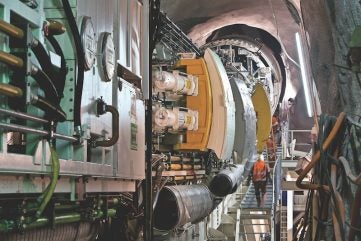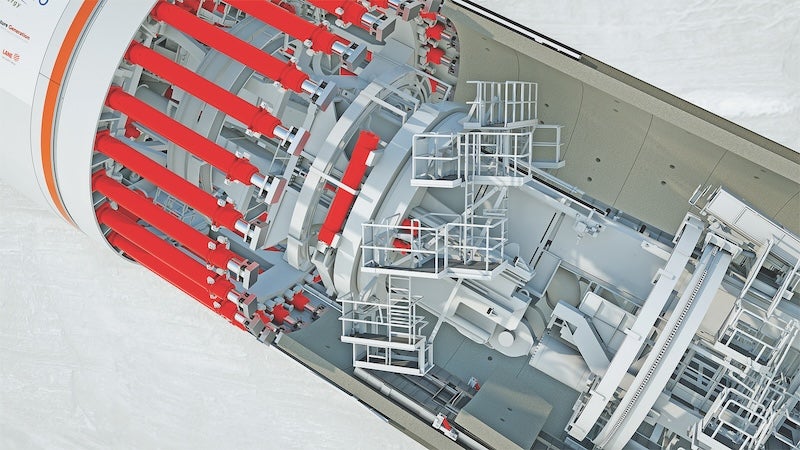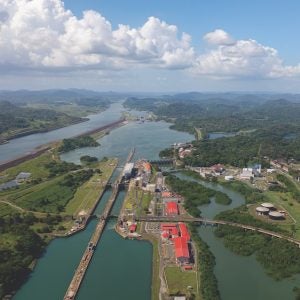
Even the seasoned tunnellers aboard the tunnel boring machine (TBM) felt the anticipation. On October 3, 2022, after three months of excavation, TBM S-1319 pierced through to the target cavern of the Limberg 3 hydropower project deep in the High Tauern mountain range near Salzburg, Austria. It was a moment to celebrate. “At that moment, the tension of many months fell away from us,” recalled Steffen Wiedemer, Herrenknecht project manager. “This was a mission I really wanted to see up close.”
The mission was a remarkable feat: the construction of a 770m-long inclined shaft at a dizzying 42-degree gradient. The 105m-long gripper TBM, weighing nearly 1,000 tonnes, was engineered to tackle the incline, far steeper than Innsbruck’s famed Bergisel ski jump. “Such a steep incline poses extreme challenges for the machine and therefore the whole team,” Wiedemer noted.
This achievement is more than just a technical milestone; it’s a symbol of how cutting-edge engineering is helping to shape the future of renewable energy. Hydropower remains a crucial pillar in the global fight against climate change, and projects like Limberg 3 demonstrate what’s possible when expertise, innovation, and determination converge.
Engineered for precision and safety
For steep-gradient projects like Limberg 3, innovation is critical. Herrenknecht’s TBM platforms, for example, tilt to match the shaft’s angle, ensuring safe and efficient excavation. Beyond the mechanical complexity, challenges often emerge from unpredictable geological conditions. Dr.-Ing. Karin Bäppler, Head of Business Development at Herrenknecht, explained: “For tunnels, exploratory drilling is done during the planning phase, but unforeseen ground conditions can still arise. In such cases, we stabilize the TBM’s path by injecting special materials into the rock.”
These cutting-edge solutions enable Herrenknecht to deliver on projects even in the toughest terrains. The Snowy 2.0 hydropower project in Australia is another example of Herrenknecht’s ingenuity. For this initiative, the back-up platforms of the TBM were specially designed to tilt, ensuring stability and functionality while constructing an inclined pressure shaft.
Unpredictable geology is an ever-present challenge in tunnelling. Fault zones – areas where rock formations have undergone structural changes – can pose serious risks. However, Herrenknecht’s team employs advanced injection techniques to stabilize problematic geology. These innovations reflect the company’s commitment to ensuring both safety and project success.
“Such a steep incline of a 42-degree slope poses extreme challenges for the machine and therefore the whole team,” Wiedemer reiterated. His statement underscores the intricate interplay of engineering and teamwork that defines these ambitious hydropower projects.

Hydropower: a green energy mainstay
Ambitious hydropower projects like Limberg 3 underscore the global urgency to expand renewable energy sources.
Herrenknecht’s work on hydropower projects is nothing new. In Ecuador, the Coca Codo Sinclair waterworks, operational since 2016, provides 30% of the nation’s electricity. This massive facility features two 9.11m diameter Double Shield TBMs, which excavated nearly 25km of inlet tunnels. The project’s 1,500MW capacity underscores hydropower’s potential to transform national energy grids.
Austria, where Limberg 3 is under construction, is another leading example. The Alpine nation already generates 67% of its electricity from hydropower and is pushing for climate neutrality by 2040. Limberg 3, with its steep pressure shaft and innovative design, represents a significant step toward that goal. Once operational in 2025, it will join the Kaprun power plant group, contributing to grid stability and renewable energy storage.
Not every project involves massive infrastructure. In Italy’s Val d’Astico, Herrenknecht’s HDD Trailer Rig installed an 8-inch pipeline for a small hydropower plant, overcoming a 450-meter elevation difference over nearly a kilometer. These diverse projects – from vast tunnels to compact installations – highlight the versatility and importance of hydropower in the global energy transition.
The future: green power banks
Hydropower’s appeal lies not just in electricity generation but also in its potential for energy storage. Pumped storage power plants like Limberg 3 double as green power banks.
In the Kaprun Valley, this concept has been in action for nearly 70 years. Limberg 3’s steep pressure shaft, built with Herrenknecht’s TBM, adds a new dimension to this storied tradition. The plant’s two 240MW turbines will produce electricity for thousands of homes, helping Austria meet its renewable energy targets.
Visitors to the Kaprun Valley can experience this engineering marvel firsthand. A thrilling via ferrata climb along the dam wall offers views of turquoise reservoirs and lush alpine landscapes. As they ascend, they witness not just the beauty of nature but the innovative efforts to secure a sustainable energy future.
Ambitious hydropower projects worldwide
Hydropower projects are becoming increasingly ambitious in response to the global push for renewable energy. The European Union, for example, aims to achieve climate neutrality by 2050. Projects like Limberg 3 are part of a broader movement to expand renewable energy infrastructure, driven by the Paris Agreement and the urgent need to combat climate change.
From 2009 to 2011, Herrenknecht’s Double Shield TBM excavated a 12.4km inlet tunnel for the Palomino hydropower station in the Dominican Republic. Operational since 2012, this 80MW facility highlights the global reach of Herrenknecht’s expertise.
Meanwhile, the Coca Codo Sinclair project in Ecuador serves as a case study in hydropower’s transformative potential. By producing 30% of Ecuador’s electricity, the facility has reduced the nation’s reliance on fossil fuels and significantly cut greenhouse gas emissions.
Driving the energy transition
Hydropower’s role in the global energy transition cannot be overstated. Projects like Limberg 3 and Coca Codo Sinclair demonstrate the scale and impact of this renewable energy source. From large-scale installations to smaller initiatives like Val d’Astico, Herrenknecht’s technology is enabling countries worldwide to meet ambitious climate targets.
Dr. Bäppler’s observation captures the essence of this movement: “We notice that projects are becoming more ambitious because renewable energy sources urgently need to be expanded if the global climate crisis is to at least be mitigated.”
As the world moves toward a sustainable future, hydropower’s ability to provide clean energy and storage solutions will remain essential. With new tunnelling innovation, the possibilities are as vast and varied as the landscapes these projects traverse.
Based on an article by Mathias Becker






